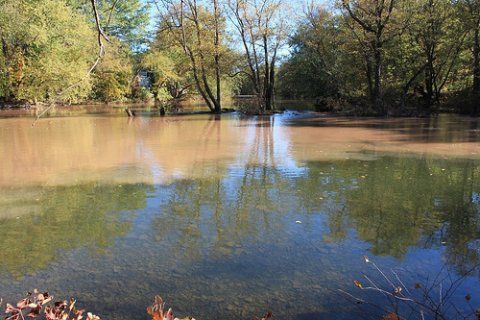
More details are emerging about Ulster County's threat to sue the New York City Department of Environmental Protection over its releases of turbid water into the Lower Esopus.
William Kemble at the Daily Freeman reports that County Executive Mike Hein was "visibly angry" when he made the announcement about the lawsuit last night.
The Freeman also printed a letter today from Paul Rush, the deputy commissioner of the DEP, once again explaining the DEP's position that, in fact, the Ashokan reservoir actually keeps the Esopus clean:
Neither the Ashokan Reservoir nor its waste channel cause turbidity in the lower Esopus Creek; in fact, the reservoir reduces it. The Esopus Creek becomes naturally turbid due to clay deposits after heavy rain. This would be seen in the entire creek if not for the reservoir, which helps reduce turbidity by acting as a buffer between the upper and lower sections of the creek.
Because turbid, muddy water from the Upper Esopus settles out when it reaches the Ashokan, Rush writes, turbid water that is released downstream into the Lower Esopus is cleaner that it would be if the reservoir weren't there:
The maximum turbidity of this released water is many multiples below the maximum turbidity in the upper Esopus during storms, due to mixing and settling that occurs in the reservoir.
Farrell Sklerov, a spokesman for the DEP, emailed out a statement last night minutes after the news of the lawsuit broke emphasizing the city's commitment to keeping the Esopus clean:
“We do not believe we are violating any state or federal law but we will review any legal actions when they are received. And we understand that turbidity in the lower Esopus is undesirable, and could have some adverse impacts on local communities. We are working to mitigate those impacts as much as possible, but today’s announcement seems to disregard the interconnected nature of the water system, which must balance water supply from various sources to provide clean water. Decisions about how to manage reservoir operations impact multiple stakeholders—including upstate counties and towns. Rather than threatening legal action, everyone should work together to reach a solution that protects all of the important, but sometimes competing, interests at stake. DEP is meeting with stakeholders this Friday to follow-up on our commitment to make clear water releases for the first time ever into the lower Esopus, and we are working closely with the State Department of Environmental Conservation, the Environmental Protection Agency and local elected officials in Ulster and other nearby counties to ensure that we strike the right balance between maintaining drinking water quality for nine million New Yorkers—including one million non-city residents—and protecting the ecology of local waterways.
But residents of Lower Esopus towns think otherwise. In December, Saugerties Village Trustee Kelly Myers explained to the Saugerties Times how the water releases from the Ashokan are causing problems downstream. It's not the fact that the city releases the turbid water, she said -- it's the timing of when it does so:
The Ashokan Reservoir is not the only source of turbid water in the Esopus. In fact, turbidity is a common and natural occurrence. However, turbidity caused by rain and other natural factors tends to wash away within a few days, explained Myers. With daily turbid water releases, this is not happening, and the Esopus is filling with increasing amounts of mud and silt. The problem is cumulative, says Myers. As this thick, muddy water proceeds down the creek, more sediment is churned up, causing riparian erosion, farmland erosion, stream bank failure, and septic system failures. By the time this water reaches Saugerties, and the mouth of the Esopus, its destructive power is at its highest.
Much of the outrage against the DEP is probably fueled by the visual evidence of muddy water mixing with clean water in the Esopus downstream of the Ashokan. It just doesn't look good, as you can see in the photo above, submitted to the Times Herald-Record in October and reposted here with permission.
And it's worth remembering that fights over turbidity downstream of NYC reservoirs have happened before in court. Here's the Riverkeeper's narrative of how it attempted to clean up the Esopus Creek below the Schoharie Reservoir in court, with mixed (and, er, turbid) results.
For more on the Ashokan turbidity issue, see our previous coverage here.














